
Alphonsus is an ancient impact crater on the Moon that dates from the pre-Nectarian era. It is located on the lunar highlands on the eastern end of Mare Nubium, west of the Imbrian Highlands, and slightly overlaps the crater Ptolemaeus to the north. To the southwest is the smaller Alpetragius. The crater name was approved by the IAU in 1935.

Arzachel is a relatively young lunar impact crater located in the highlands in the south-central part of the visible Moon, close to the zero meridian. It lies to the south of the crater Alphonsus, and together with Ptolemaeus further north the three form a prominent line of craters to the east of Mare Nubium. The smaller Alpetragius lies to the northwest, and Thebit is to the southwest along the edge of the mare.

Fra Mauro is the worn remnant of a walled lunar plain. It is part of the surrounding Fra Mauro formation, being located to the northeast of Mare Cognitum and southeast of Mare Insularum. Attached to the southern rim are the co-joined craters Bonpland and Parry, which intrude into the formation forming inward-bulging walls. The crater is named after Italian geographer Fra Mauro.

Albategnius is an ancient lunar impact crater located in the central highlands. It is named after the Mesopotamian Muslim astronomer and scientist Abū ʿAbd Allāh Muḥammad ibn Jābir ibn Sinān al-Raqqī al-Ḥarrānī aṣ-Ṣābiʾ al-Battānī, Latinized as Albategnius.
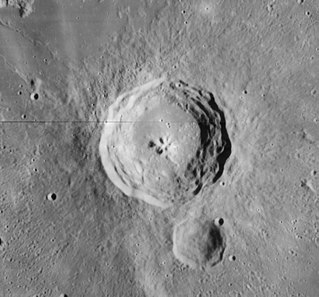
Bullialdus is a lunar impact crater located in the western part of the Mare Nubium. It was named after French astronomer Ismaël Boulliau. To the north by north-west is the broken-rimmed and lava-flooded crater Lubiniezky. South-west of Bullialdus lies the smaller crater König.

Ammonius is a bowl-shaped lunar impact crater with a slightly raised rim. It is located on the floor of the walled plain Ptolemaeus, about 30 kilometers northeast of the crater midpoint.
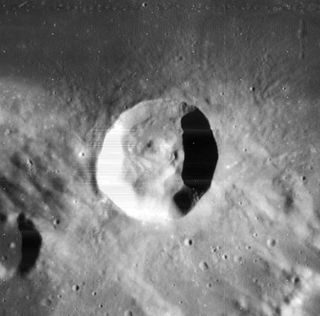
Menelaus is a young lunar impact crater located on the southern shore of Mare Serenitatis near the eastern end of the Montes Hæmus mountain range. Its diameter is 27 km. To the southwest is the small crater Auwers, and to the west-southwest is the even smaller Daubrée. To the northeast is a faint rille system named the Rimae Menelaus.

Thebit is a lunar impact crater located on the southeast shore of Mare Nubium. To the north-northwest is the crater Arzachel, and Purbach lies to the south-southwest. To the southwest is the flooded remnants of Thebit P, which is actually larger in diameter than Thebit itself.
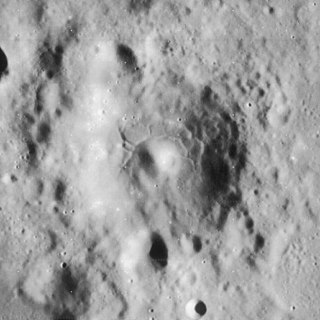
Airy is a lunar impact crater located in the southern highlands. It is named in honour of British astronomer George Biddell Airy. It forms the southernmost member of a chain of craters consisting of Vogel, Argelander, and Airy. A little further to the south lies Donati. Airy has a worn, and somewhat polygonal rim that it broken at the northern and southern ends. It has an irregular floor and a central peak.
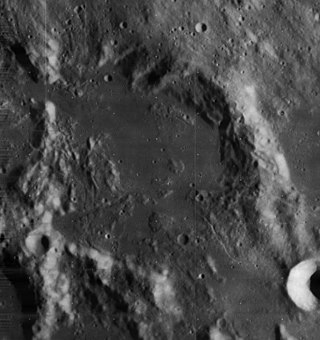
Murchison is a lunar impact crater on the north edge of the Sinus Medii. It was named in honour of the geologist Sir Roderick Murchison. It shares a section of rim with the crater Pallas. To the southeast on the mare is the circular crater Chladni, and to the northeast is Ukert. Farther to the east is the prominent Triesnecker. Murchison lies astride the lunar zenith line, i.e. the starting longitude of the selenographic coordinate system.

Hipparchus is the degraded remnant of a lunar impact crater. It was named after the Greek astronomer, geographer and mathematician Hipparchus. It is located to the southeast of Sinus Medii, near the center of the visible Moon. To the south is the prominent crater Albategnius, and to the southwest lies Ptolemaeus, a feature of comparable dimensions to Hipparchus. Horrocks lies entirely within the northeast rim of the crater. Halley is attached to the south rim, and Hind lies to the southeast. To the north-northeast is the bowl-shaped Pickering, and the flooded Saunder is located off the northeast rim. High-resolution images of Hipparchus were obtained by Lunar Orbiter 5 in 1967.

Alpetragius is a lunar impact crater located on the eastern edge of Mare Nubium, to the southwest of the much larger crater Alphonsus. In the southeast is the prominent crater Arzachel, and to the west lies the flooded Lassell. Alpetragius is a Latinization of the name of Nur ad-Din al-Bitruji, a Spanish-Arab astronomer.

Burnham is a small crater located to the southeast of the crater Albategnius, in a relatively smooth area of the lunar surface. It was named after American astronomer Sherburne W. Burnham. To the southwest is Vogel.

Bianchini is a lunar impact crater that lies along the northern Jura Mountains that ring the Sinus Iridum, in the northwestern part of the near side of the Moon. It was named after Italian astronomer Francesco Bianchini. The impact of this crater near the edge of the Jura Mountains deposited some material into the Sinus Iridum floor.
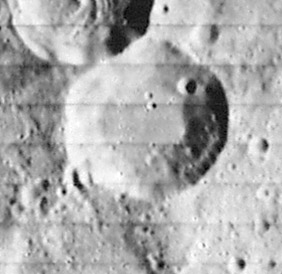
Azophi is a lunar impact crater that lies in the rugged south-central highlands of the Moon. The crater is named after the 10th-century Persian astronomer Abd Al-Rahman Al Sufi, also known by his western name, Azophi. The northwest rim is attached to the slightly smaller crater Abenezra, to the east-southeast is the large and irregular Sacrobosco, and to the west-southwest is Playfair.

Davy is a small lunar impact crater that is located on the eastern edge of the Mare Nubium. It was named after British physicist Humphry Davy. It overlies the lava-flooded remains of the satellite crater Davy Y to the east, a formation which contains a crater chain designated Catena Davy. To the southeast of Davy is the prominent crater Alphonsus.

De La Rue is the remnant of a lunar impact crater, or possibly several merged craters, creating a formation sometimes called a walled plain. It lies in the northeastern part of the Moon on the near side, and so appears foreshortened due to its location. This formation lies to the north-northwest of the prominent crater Endymion, just beyond the eastern extreme of Mare Frigoris. The crater Strabo intrudes into the northern part of De La Rue's northern rim, and the smaller Thales is attached to the northwestern part of the wall.
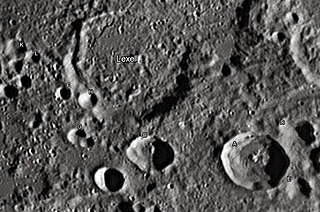
Lexell is a lunar impact crater that lies across the southeastern rim of the huge walled plain Deslandres, in the southern part of the Moon. It was named after Swedish-Russian mathematician and astronomer Anders Johan Lexell. To the northeast is the walled plain Walther, and to the south is Orontius, another walled plain.

De Sitter is a lunar impact crater that is located near the northern limb of the Moon, to the north of the Baillaud–Euctemon crater pair. Due to its location, this crater appears very foreshortened when viewed from the Earth, limiting the detail that can be viewed. The crater also receives sunlight at a low angle, when it is on the sunlit side.

Wurzelbauer is the remnant of a lunar impact crater. It was named after German astronomer Johann Philipp von Wurzelbauer. It is located in the rugged terrain on the Moon's southern hemisphere. The slightly smaller crater Gauricus lies next to the eastern rim, while to the north-northeast is Pitatus.
























